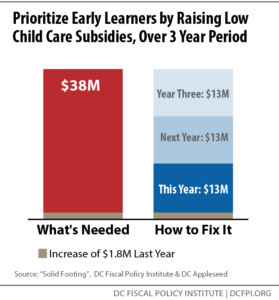The District should take a number of steps to improve the care and education of our youngest children, infants and toddlers, but one of the key steps is to make sure providers of this care get the resources they need to offer supportive and stimulating environments. As DC’s leaders gets closer to putting together a budget for next year, they should make it a priority to invest more in the child care subsidy program for lower-income parents.
Access to affordable, high-quality early learning can reduce the achievement gap that begins before children even reach a pre-K classroom. High-quality early education—in a child care center or with a home-based provider—supports school readiness and improves health outcomes later in life, all while relieving hard-working parents.
 The District demonstrated an impressive commitment to advancing early education by implementing an expansive Pre-K program, with families able to choose among three sectors: traditional public schools, public charter schools, and community-based organizations. But the departure of preschool children for public school classrooms exacerbated the already-considerable financial challenges facing community-providers who serve infants and toddlers, particularly those in low-income neighborhoods.
The District demonstrated an impressive commitment to advancing early education by implementing an expansive Pre-K program, with families able to choose among three sectors: traditional public schools, public charter schools, and community-based organizations. But the departure of preschool children for public school classrooms exacerbated the already-considerable financial challenges facing community-providers who serve infants and toddlers, particularly those in low-income neighborhoods.
There is a large gap between the subsidy payments these providers receive from DC’s child care subsidy program and the actual costs of providing high-quality care to infants and toddlers, as noted in our 2016 report with DC Appleseed. As a result, many community-based organizations serving our youngest, low-income learners struggle to provide quality care. Nearly half of the providers in our study operated at a loss, some even going into personal debt to float their Center’s operations. Teachers and staff in DC’s early education centers perform critical and demanding jobs, yet they are among the lowest-paid workers, earning only $26,900 on average, which contributes to turn-over and stress in the workforce. And some providers are reluctant to take the steps needed to meet the city’s highest quality rating because they do not receive enough additional funds to meet their higher costs, according to testimony at a DC Council hearing this week.
Our research found that an increase of $38 million in the subsidy payment rates is needed to cover the actual costs of caring for infants and toddlers. This increase could be phased in over several years, such as $13 million per year over a three-year period. We also recommend the District consider differentiated subsidy rates, such as higher rates for providers in high-poverty neighborhoods, or that serve a large number of children with special needs. Community-based providers can then invest these additional funds in attracting and retaining good teachers, earning higher quality ratings, and better serving the young children in their care.
